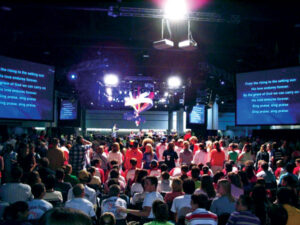Technology is the single most significant characteristic of modern western culture. Canadian philosopher George Grant contends it has long displaced democracy and capitalism as top identifiers. Technology directly shapes Christian belief and practice in ways we must at the very least question, if not actively resist.
The Mennonite church has not paid adequate attention to discerning how technology shapes our theology and practice of worship, and our patterns of relating to each other. Today, we are more likely to shape our understanding of who Jesus is and how he related to others by our own use of technology than we are to shape our use of technology by our understanding of who Jesus is and the nature of the kingdom Jesus inaugurates.
Reflections on technology and worship at the global youth summit
Three observations from worship services at the global youth summit at the Mennonite World Conference assembly in Paraguay in 2009 serve as a starting point to evaluate the effects of technology on worship and Christian communication:
- Those who used the sound system wielded great power over the gathered body. The collective voices of worshippers were drowned by the few with microphones and amplifiers. The worship band was so loud that during the gathering time it was impossible to fellowship with people from other countries, and during worship it was impossible to make a discernable contribution to praise with your own voice. We had built an audio Tower of Babel, staking a claim for ourselves in heaven and on earth.
- Technology tended to homogenize our worship. While genuine attempts were made to allow youth from each continent to lead worship in a style that reflected their context, the presence of high-tech equipment and a talented worship band proved a temptation too strong for many to resist. The worship leaders from some continents adopted an American Idol-style, egoistical, sexualized and audience-pandering stage presence. Other continental worship leaders simply felt inadequate and deferred to the worship band.
- The style of worship dependent on electronic technology worked against the theme of the summit: “Service: Live the difference.” Philippians 2:1-11 emerged as a guiding passage: “Do nothing from selfish ambition or conceit, but in humility regard others as better than yourselves.” Angelica Rincon-Alonso of Colombia characterized the elements of service as “collaboration, love, solidarity, humility, solutions, compassion, gifts and talents.” Of these themes, only love emerged prominently in the worship songs, where it was almost exclusively in reference to loving God or Jesus.
This is not to say these themes were never addressed. They were addressed in a number of the messages, prayers and confessions. There were, in fact, times for meaningful interaction, such as at meals and workshops. The point is that the times we relied most heavily on technology were also the times we were most fragmented and disconnected from each other. The times we relied most heavily on technology were the times the global body was most foreign and distant, and where biblical themes such as solidarity, humility and compassion were most absent.
We are united as Anabaptist Christians not merely by the faith and practices we hold in common, but more importantly by the Holy Spirit, who unites us in, and because of, our diverse expressions of faith. The unity of the Spirit, however, is undermined and diminished by the tendency of technology to homogenize and universalize. Without wise analysis of our use of technology to communicate and to mediate worship, we are likely to settle for a shallow, technology-induced homogeneity, rather than rich, contextually appropriate expressions of faith in the one, true God.
Four questions emerge from these observations:
- What is the core problem with technologically mediated worship and communication?
- How is what we communicate connected with the way we communicate?
- Doesn’t technology help us communicate more efficiently, and isn’t efficiency a good thing?
- Should our understanding of Christian worship and communication be shaped primarily by western technological culture or by the Incarnation?
Technology and incarnation: Competing modes in communicating the gospel
Jesus asserts, “I am the way, the truth and the life” (John 14:6). To take Jesus’ claim seriously requires that we consider how technology makes similar claims. Like Jesus, technology invites us to follow a certain way, to view truth in a certain way, and to a certain experience of life. Are the way, truth and life promised by technology consistent with the way, truth and life promised by the One who first made this claim?
If the church of the future is going to be founded on the way, truth and life of Jesus, rather than on technology, the church needs to develop a language and tools to evaluate our degree of “at-home-ness” with technology and discern ways in which technological life is incommensurate with life in Jesus.
Technology is not neutral tools and gadgets
One dominant myth about technology is that it is merely a collection of tools or gadgets we use every day. Another is that these tools and gadgets are neutral, neither good nor bad until taken into human hands. Those suggesting technology is neutral might say: “Technology is like a hammer. You can use it to build a house or to kill. The hammer does not tell you how to use it; the user decides.” This logic is used by the National Rifle Association, expressed in their well-known slogan, “Guns don’t kill people, people kill people.”
This popularly held view does not take into account that with a hammer or gun in my hand my identity becomes that of someone who hits or shoots, and I come to see the world as filled with objects to hit or shoot. The pattern by which I relate to God, to others and to creation is in this way shaped by technology. It is too often a pattern of objectification and violence.
This technological pattern can be understood in terms of the following three aspects, each measureable against the grain of Jesus’ life and teaching:
- Medium and message come together in the incarnation.
One characteristic of the technological pattern is that the method of communication is often disconnected from the message itself. Consider this extreme example: If “Jesus loves you” is spray-painted on the side of a bomb being dropped on a Muslim village, the carrier of the message is inconsistent with the message itself. Or consider this less extreme example: A popular girl wears a T-shirt that says, “Jesus loves you,” but she does not welcome others into her clique. Her exclusive behaviour is inconsistent with the message on her shirt.
When Jesus called the disciples, Philip tells Nathanael that Jesus is the one promised by Moses and the prophets to be the Word made flesh. Nathanael replies, “Can anything good come out of Nazareth?” (John 1:14, 46). Nathanael questions whether the medium—a simple man from a two-bit village—could bear the divine message.
As it turns out, being from Nazareth is at the heart of the incarnation. As theologian John Howard Yoder reminds us, the good news is both the message of salvation and the messenger: Jesus, who embodies the message. In Jesus, the medium and the message are bound together but not conflated. And in Jesus, difference and particularity are valued, not eradicated.
- Efficiency is the golden calf of western culture.
Another characteristic of the technological pattern is efficiency. Efficiency is the golden calf of our age, a false god we worship when we are too self-consumed to discern the presence of God or too impatient to wait in silence for God to appear. Greater efficiency is the promise of every new tool, toy or gadget. Philosopher Albert Borgmann observes that efficiency presents itself in the ever-renewed promises of devices to be faster, easier to use, safer and more portable. At least one of these promises is present in every device or service advertised.
Technological efficiency is problematic when it becomes an end in itself. When this happens, we lose the ability to seriously weigh what we gain against what we lose with each technological adaption, and we confuse efficiency for efficacy. The rate of technological change today far outpaces our ability to consider whether we should accept each change, in part because overwhelming complexities are uncovered with deep discernment. The key loss with our fixation on efficiency is the distinct possibility that things like faith formation, community, witness and worship are only faithfully and properly found by the slower, more vulnerable, harder and less portable means.
- Life, liberty and happiness are not Jesus’ values.
In the early Modern period, Europeans began revolting against tradition and oppressive political, social, economic and moral restrictions placed on the average person. As European settlers moved to North America, they adopted technologies that helped them maximize freedom and prosperity as they cultivated the land and as they travelled and communicated over great distances. Technologies that characterize modern western civilization—the steam engine, train, automobile, telegraph, telephone, radio and television—are technologies either invented in North America or most rapidly implemented here.
Unrestricted individual freedom and prosperity became a constitutional “right” in the United States. Most American school children can quote by heart the part of the Declaration of Independence which states, “We hold these truths to be self-evident, that all men are created equal, that they are endowed by their Creator with certain unalienable rights, that among these are life, liberty and the pursuit of happiness.”
Individuals—initially, each white land-holding male—have the “right” to decide for themselves what happiness looks like. In Canada, we have a similar line in the British North America Act of 1867, guaranteeing “peace, order and good governance.” Notably, the Canadian version does not pit individual against collective freedom and prosperity to the same degree. But life, liberty and happiness do not characterize the pattern by which Jesus calls us to live. By inviting the disciples to lose their life in order to save it, Jesus calls the disciples to relinquish freedom and prosperity in order to do the will of God (Luke 9:24). Jesus still invites us today to a life of suspended personal liberties and of sacrifice for the sake of the larger body. He invites us to a happiness not defined by individual whims and desires, but to joy found in loving God and loving our neighbour (Luke 10:27).
Ministry implications
What are the implications of thinking critically about how technology forms and mal-forms the way we relate with God, with creation and with each other? How might Christians of all ages be formed to be countercultural in our use of technology so we are shaped first and foremost by the incarnational Jesus in worship and witness?
- Deepen critical reflection and model critical use of technology. Learn the language and skills of critical evaluation. Ask questions such as:
Will using this device help or hinder my relationship with God or my ability to worship God? Will using this device help or hinder my relationship with creation? Would a change in my behaviour be a better solution than a technological change?
Will using this device help or hinder my relationships with family, friends and the church community? Will this device really deepen communication, understanding, empathy or compassion? Will it divert my attention from those with whom I am physically present in favour of those who are only virtually present?
What is the overall or long-term effect of using this device? On the surface, Facebook and texting appear to foster communication, but in what ways do they ultimately fragment, atomize and disincarnate relationships? Does this device displace community with networked individualism or displace unity in the Spirit with a homogenized body?
- Seek lower-tech or electronic-free worship and fellowship experiences, observing the difference between technologically mediated relationships and incarnational relationships.
Technology is morally disorienting. It hides the complexity of issues under a veneer of efficiency and coolness (and lets face it, some gadgets are really cool). Develop the ability to notice:
What you stop worrying about when you don’t use a cell phone or Facebook for extended periods of time and what things become more important instead.
How individuals interact differently in a group when liberated from electronic distractions. How the worshipping community begins to look more like community in the New Testament and the Early Church. How we sense or feel the presence of God, Jesus, and the Holy Spirit. Increased awareness of my worshipping neighbour and how attentiveness to the whole worshipping community enhances my own ability to worship.
Increased tendency to prefer lower-tech, more personal and more time-consuming forms of communication.
- Provide believers with a hope and vision for life which empowers them to choose a countercultural lifestyle centred on Jesus’ vision of the kingdom of God.
The hope technology promises is release from “unnecessary” burdens, some of which turn out to be the very things that make us human: the necessity of work, the ability to feel pain, cultural and linguistic particularity, and being bound by time and place. The hope that God provides, by contrast, is that God is with us, embodied in Jesus and the church, as we live with joy with the burdens that remind us that life is a gift.
Our hope as Anabaptist Christians does not lie in simply being against culture or against technology. Our hope comes from participating in the New Creation (II Corinthians 5:17-18) and living with a new centre to our lives: Jesus Incarnate. Jesus calls us to actively incarnate love, justice and hope in face-to-face community. Others will only come to know truth and life in Jesus—Emmanuel, God with us—as Christians model the way through patience, intentionality, dangerous faith and local living.
Andy Brubacher Kaethler has served as associate pastor at Bethany Mennonite Church, Virgil, Ont., and as conference youth minister for Mennonite Church Eastern Canada. He currently teaches and directs the !Explore program at Associated Mennonite Biblical Seminary, Elkhart, Ind. Adapted from Youth Ministry at a Crossroads: Tending to the Faith Formation of Mennonite Youth, edited by Andy Brubacher Kaethler and Bob Yoder, by Herald Press.










Leave a Reply
You must be logged in to post a comment.